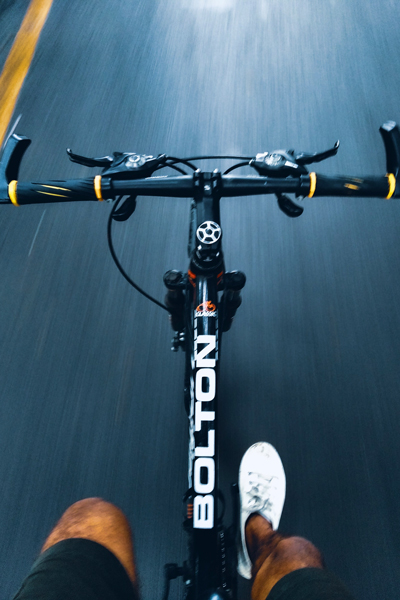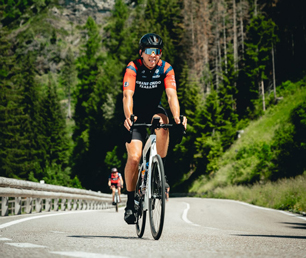Unlock your potential as a cyclist with strength training!
- Master in Physical Education (KULeuven)
- Coach KULeuven University Sports Center
- Additional education Bikefitting
- Personal Trainer, Bootcamp Trainer & Corporate Trainer (ING)
Read more about Coach Dries
Through targeted strength training in function of cycling, you will work on sport-specific strength exercises to improve your performance.
Coach Dries Benoit rode himself as a recreational cyclist several events such as the Ronde Van Vlaanderen, Maratona Dles Dolomites, 300km around Limburg,... and thus has built up practical experience around cycling in addition to his theoretical knowledge.
Are you a dedicated (recreational) cyclist who dreams of better performance, a higher FTP, better endurance or more speed? Then strength training is the key to success! Find out how strengthening your body can help you reach your cycling goals and take your cycling adventure to new heights.
We focus the exercises on the specific discipline of the cyclist (climber, sprinter or time trialist) and on building core stability or trunk stability. Training sessions will be adapted via a periodised build-up in both intensity and training method. Injuries will always be taken into account.
Core stability
Core stability refers to the strength and stability of the muscles in the central part of your body, especially the muscles in the abdomen, lower back, hips and pelvis. Core stability is essential for cyclists for several reasons:
-
Improved riding position
A strong and stable core helps cyclists maintain an efficient riding position. This is especially important during long rides and climbs, as it reduces fatigue symptoms and improves overall performance.
-
Improved power transfer
When you pedal, power comes from your legs to the bike via your torso. A strong core allows for a more efficient transfer of power, resulting in improved pedalling technique and speed.
-
Injury prevention
Core stability can help reduce strain on your spine and joints, reducing the risk of overuse injuries such as lower back pain.
-
Improved balance and agility
A strong core helps maintain balance and stability, which comes in handy while steering and manoeuvring on the bike.
-
Reduced fatigue
A strong core allows you to better support and stabilise your body, saving energy and reducing fatigue, especially during long rides or time trials.
-
Improved breathing
A strong core makes it easier to breathe deeply and efficiently, which is vital for endurance performance and stamina.
Core stability training includes exercises aimed at strengthening the abdominal muscles, back muscles, hip muscles and pelvic floor muscles.
Discipline-specific training
Strength training can be adapted to the specific needs of different types of cyclists: time trialists, climbers and sprinters. Here is what is important in strength training for each type of cyclist:

Time trialists are focused on maximum aerodynamics and maintaining a constant wattage over a long period of time. For time trialists, strength training is important for:
-
Core stability and body positioning
A strong core is essential to maintain a stable and aerodynamic posture during a time trial.
-
Power (wattage) and endurance
Time trialists need to develop their leg muscles to deliver constant wattages throughout the time trial.

Climbers need to maximise their strength-to-weight ratio to cope with steep slopes. Important aspects of strength training for climbers are:
-
Strength vs muscle weight
Climbers need to develop their leg muscles to exert power during climbs, but also need to control their body weight. To this end, it is important for climbers not to focus specifically on increasing their muscle mass but rather on increasing their muscle strength.
-
Muscular endurance
Long climbs require muscle endurance. Strength training should focus on developing muscle endurance to reduce fatigue.
-
Core and upper body
A strong core and upper body help maintain stable posture and efficient breathing during climbing.

Sprinters need to be able to put in short, powerful efforts to beat their competition. Here is what is important about strength training for sprinters:
-
Maximum strength
Sprinters need high maximum strength to develop speed during sprints. Heavy strength training is essential.
-
Rapid explosive power
Besides maximum strength, sprinters need to work on explosive power to accelerate quickly.
-
Core stability
A strong core helps with stability and control during explosive efforts.
As (recreational) cyclists, we often underestimate the importance of strength training on our cycling performance. It is also important to adopt a specific form of strength training for your specific goal.
Are you (in addition) looking for guidance and follow-up to your workouts on the bike? Then I will help you as a coach regardless of the discipline you do cycling in. For cyclists with different specialities, there are specific training methods and workouts that can improve their performance. These different workouts are all prepared by us with the program https://intervals.icu/. This program has the same functionalities as trainingpeaks, for example. In particular, this program helps coaches structure workouts and allows you to upload these workouts to your sports watch or zwift. By using a power meter or heart rate monitor, the evolution in condition and the accumulation of fatigue can be monitored. With all these parameters, you can ideally prepare for your next goal without all the headaches of structuring your workouts.
Examples of training needs
Here are examples of the different training needs on the bike for climbers, time trialists and sprinters:

-
Intervaltraining
Targeted high-intensity intervals to raise the lactate threshold and improve the ability to maintain consistently high speeds.
-
Pace training
Training based on a constant pace, similar to the pace of a time trial, to improve high-speed endurance.
-
Aerobe training
Long and steady rides with a focus on aerobic development and improving the ability to deliver power for longer periods.

-
Climb training
The focus is on long climbs to improve strength, endurance and climbing technique. Workouts include repeated climbs of hills or mountains, cycling both seated and standing.
-
Intervals
Training sessions with short, intense efforts followed by rest periods to develop both anaerobic and aerobic capacity. This mimics the exertion required during steep climbs.
-
Long endurance rides
Long endurance rides are essential to build the endurance needed to cope with longer climbs. The goal is to keep riding consistently and at moderate intensity for longer periods.

-
Sprints and accelerations
Workouts focused on short and powerful efforts, accelerating repeatedly to improve the explosive power needed for sprints.
-
High-intensity intervals
Short, intense intervals of maximum effort followed by rest to improve anaerobic capacity and speed.
-
Power rides
Train at a higher gear to increase the strength needed to develop and maintain speed during sprints.
Regardless of a cyclist's speciality, consistency in training and a balanced training programme is crucial. Variation in training, rest periods and attention to recovery are also key to preventing injury and improving overall performance.
Cardiovascular system
Different training modalities for cyclists, such as climbers, time trialists and sprinters, focus on different cardiovascular aspects and can have different effects on the cardiovascular system:

-
Aerobic and anaerobic capacity
Time trialists focus on constant high speeds for longer periods. This improves both aerobic and anaerobic capacity as they work to maintain high intensity with minimal variation in speed.
-
Lactate threshold
By doing interval training and tempo training, time trialists can raise their lactate threshold. This allows them to work at higher intensities before lactic acid builds up in the muscles.

-
Aerobic capacity
Climbers often work on long climbs, which improves aerobic capacity. This type of training helps increase heart and lung capacity to transport oxygen more efficiently to working muscles.
-
Lactate threshold
Because climbers often work in higher-intensity zones, training on steep slopes helps raise their lactate threshold. This means they are better able to maintain higher intensities without muscle acidification.

-
Aerobic capacity
Sprint training focuses heavily on short, intense efforts. This improves anaerobic capacity, which is essential for rapid accelerations and short bursts of maximum effort.
-
Fast muscle contractions
Training for sprints improves the ability of muscles to contract quickly and forcefully, which is important for generating speed and power during sprint efforts.
In general, training modalities vary in their impact on the cardiovascular system. Climbing training focuses more on duration and endurance at lower intensities, while time trial training is a mix of high aerobic and anaerobic efforts. Sprint training, on the other hand, focuses mainly on short, intense peak efforts.
It is important to note that a combination of these training modalities can be beneficial for cyclists as it improves overall cardiovascular health, increases performance and challenges the body at different levels of intensity and duration.
Questions?
If you have any questions about our training modalities for cycling, please feel free to contact us without any obligation.
Contact









